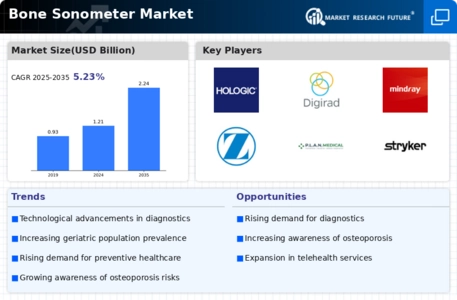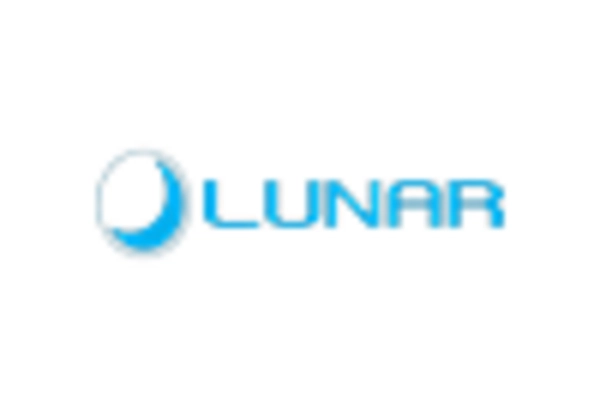The Bone Sonometer Market is currently characterized by a dynamic competitive landscape, driven by technological advancements and an increasing emphasis on preventive healthcare. Key players such as GE Healthcare (US), Hologic (US), and OsteoSys (KR) are at the forefront, each adopting distinct strategies to enhance their market presence. GE Healthcare (US) focuses on innovation through the development of advanced imaging technologies, while Hologic (US) emphasizes strategic partnerships to expand its product offerings. OsteoSys (KR) is leveraging regional expansion to penetrate emerging markets, thereby diversifying its revenue streams. Collectively, these strategies contribute to a competitive environment that is increasingly shaped by technological innovation and strategic collaborations.
In terms of business tactics, companies are increasingly localizing manufacturing to reduce costs and enhance supply chain efficiency. The Bone Sonometer Market appears moderately fragmented, with several players vying for market share. This fragmentation allows for a variety of competitive strategies, as companies seek to differentiate themselves through unique product offerings and localized services. The collective influence of these key players is significant, as they drive market trends and set benchmarks for quality and innovation.
In August 2025, Hologic (US) announced a strategic partnership with a leading telehealth provider to integrate its bone health solutions into remote patient monitoring systems. This move is likely to enhance patient access to bone health assessments, aligning with the growing trend of digital health solutions. By integrating its technology with telehealth platforms, Hologic (US) positions itself as a leader in the digital transformation of healthcare, potentially increasing its market share in the bone health segment.
In September 2025, GE Healthcare (US) launched a new portable bone sonometer designed for use in outpatient settings. This innovation is significant as it addresses the increasing demand for point-of-care testing, allowing for quicker diagnosis and treatment decisions. The introduction of this product not only enhances GE Healthcare's portfolio but also reflects a broader trend towards portable and user-friendly medical devices, which could reshape patient care in various settings.
In July 2025, OsteoSys (KR) expanded its operations into Southeast Asia, establishing a manufacturing facility in Vietnam. This strategic move is indicative of the company's commitment to tapping into emerging markets, where the demand for bone health diagnostics is on the rise. By localizing production, OsteoSys (KR) may reduce operational costs and improve supply chain efficiency, thereby enhancing its competitive edge in the region.
As of October 2025, the Bone Sonometer Market is witnessing trends such as digitalization, sustainability, and the integration of artificial intelligence in diagnostic processes. Strategic alliances are increasingly shaping the competitive landscape, as companies collaborate to enhance their technological capabilities and market reach. Looking ahead, competitive differentiation is likely to evolve from traditional price-based competition to a focus on innovation, advanced technology, and reliable supply chains. This shift underscores the importance of adaptability and forward-thinking strategies in maintaining a competitive advantage in the rapidly changing healthcare environment.


















Leave a Comment